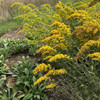
Solidago nemoralis - GRAY GOLDENROD
One of the shortest goldenrods with significantly gray leaves and towards one side nodding flowers. Excellent plant for dry, lean, poor soils, where nothing else grows....
2' tall x 1' wide (grows taller in richer or moist soil). Flowers in August to September for 1.5 months.
Full sun, half shade, dry, poor soils, rocky, sandy, infertile, dry clay,...
This plant in ideal conditions, can form clonal colonies, but most likely it will just selfseed (unless you dead-head it). But seedlings are easy to pull out.
It's native to most states of USA, except western states. Hardy in zones 3 to 9.
It is also great pollinator plant and offers pollen and nectar for native long-tongued bees, short-tongued bees, honey bees, Sphecid and Vespid wasps, flies, butterflies, moths, and beetles. Host plant for several moths and some small beetles.
It's also good bird plant - goldfinches, Greater Prairie Chicken and other gamebirds feed on the seeds, flowerheads, and leaves. Deer and rabbit may nibble on foliage, but it's not preferable food for them.
Can be used in flower bed with drier soil. It is ornamental with it's gray-colored leaves, until it bursts into blooms.
But probably the best use is to let in naturalize in dry meadows, pollinator and butterfly gardens, wild gardens, cottage gardens, dry infertile slopes, dry clay, where plants can naturalize and other plants fail.
Picture copyright :US Perennials nursery
Pot size : square 3.5" x 4" deep perennial pot

Solidago nemoralis - GRAY GOLDENROD
One of the shortest goldenrods with significantly gray leaves and towards one side nodding flowers. Excellent plant for dry, lean, poor soils, where nothing else grows....
2' tall x 1' wide (grows taller in richer or moist soil). Flowers in August to September for 1.5 months.
Full sun, half shade, dry, poor soils, rocky, sandy, infertile, dry clay,...
This plant in ideal conditions, can form clonal colonies, but most likely it will just selfseed (unless you dead-head it). But seedlings are easy to pull out.
It's native to most states of USA, except western states. Hardy in zones 3 to 9.
It is also great pollinator plant and offers pollen and nectar for native long-tongued bees, short-tongued bees, honey bees, Sphecid and Vespid wasps, flies, butterflies, moths, and beetles. Host plant for several moths and some small beetles.
It's also good bird plant - goldfinches, Greater Prairie Chicken and other gamebirds feed on the seeds, flowerheads, and leaves. Deer and rabbit may nibble on foliage, but it's not preferable food for them.
Can be used in flower bed with drier soil. It is ornamental with it's gray-colored leaves, until it bursts into blooms.
But probably the best use is to let in naturalize in dry meadows, pollinator and butterfly gardens, wild gardens, cottage gardens, dry infertile slopes, dry clay, where plants can naturalize and other plants fail.
Picture copyright :US Perennials nursery
Pot size : square 3.5" x 4" deep perennial pot










